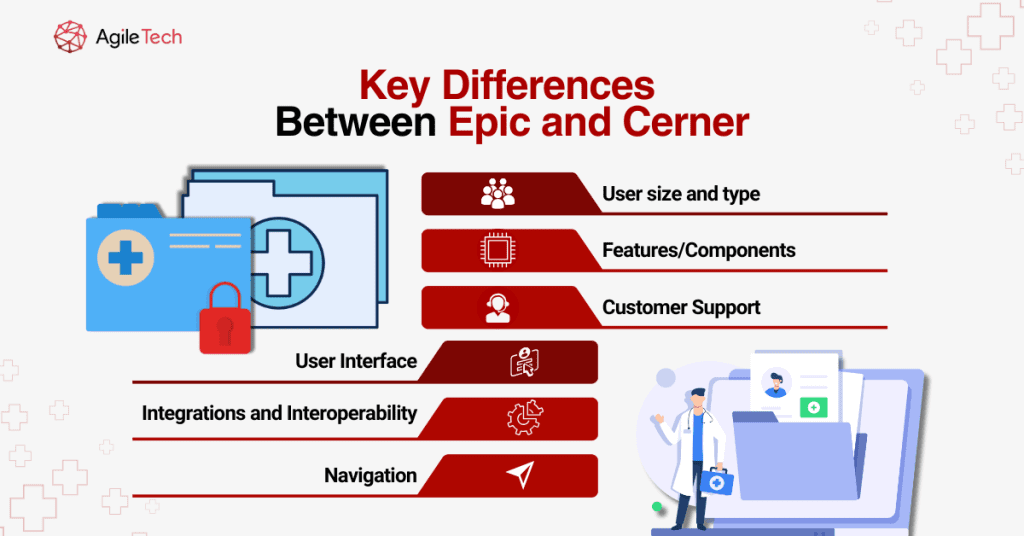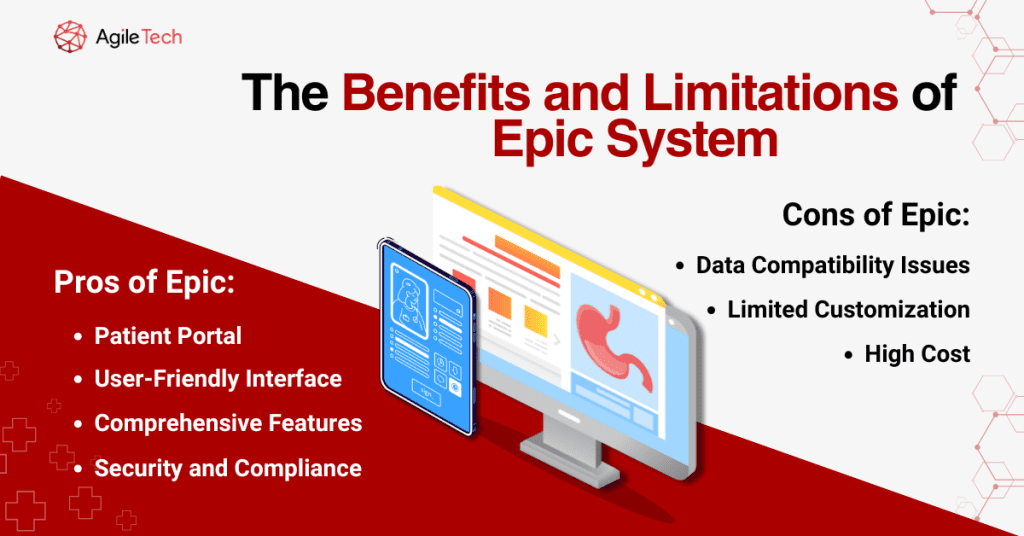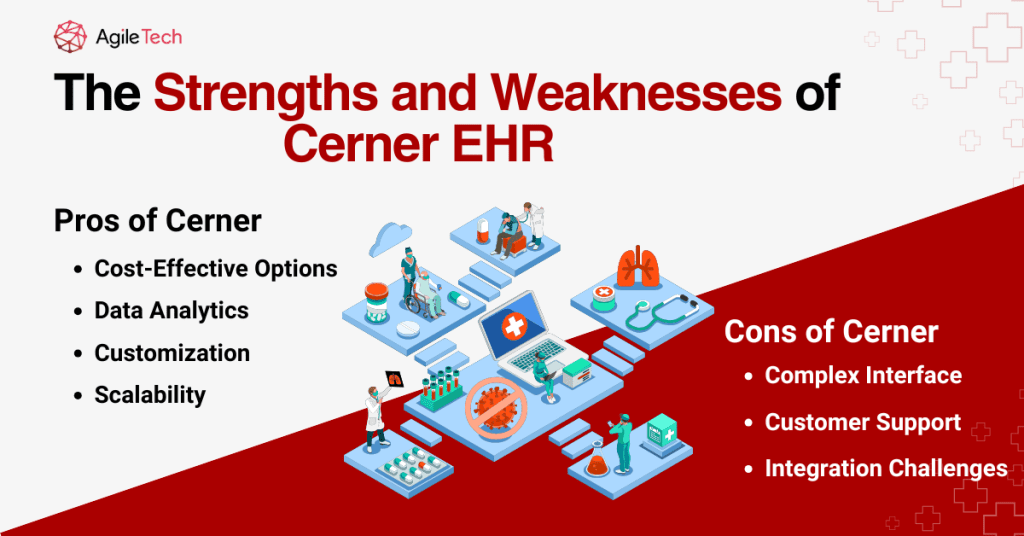Cerner vs Epic: Which EHR/EMR System Is the Best?
Selecting the right Electronic Health Record (EHR) or Electronic Medical Record (EMR) system is crucial for healthcare organizations. Two of the most widely used systems in the industry are Cerner and Epic. Both platforms offer robust solutions, but they differ in usability, cost, features, and overall efficiency. This blog post provides a detailed comparison of Epic systems vs Cerner to help you determine the best EHR system for your healthcare business.

- 1. What is Cerner? What is Epic?
- 2. Key Differences Between Epic and Cerner
- 3. Pros and Cons of Epic and Cerner
- 4. Cerner vs Epic: Which Offers Better Cost Efficiency?
- 5. Epic Systems vs Cerner: Which is Better for Your Healthcare Business?
- 6. Why Custom EHR/EMR Integration Is the Future for Healthcare Providers
- FAQs
1. What is Cerner? What is Epic?
Cerner EHR
Cerner Corporation, founded in 1979, has established itself as one of the leading global suppliers of health information technology solutions. The EHR Cerner system, officially known as Cerner Millennium, offers a comprehensive suite of digital solutions designed to connect people and systems within a unified ecosystem.
EHR Cerner provides an integrated digital record of a patient’s health journey, offering healthcare providers real-time access to patient information across various care settings. The system encompasses a wide range of clinical, financial, and operational capabilities, including:
- Clinical documentation
- Computerized physician order entry (CPOE)
- Pharmacy management
- Laboratory information systems
- Revenue cycle management
- Population health management
Cerner’s acquisition by Oracle in 2022 has introduced new dimensions to its product offerings and market positioning. Today, EMR Cerner serves thousands of healthcare facilities worldwide, from small ambulatory practices to large integrated delivery networks.
Epic Systems
Founded in 1979 by Judy Faulkner, Epic Systems Corporation has grown into a healthcare software behemoth known for its comprehensive and highly integrated EHR platform. Epic’s core philosophy centers on creating a “One Patient, One Record” environment where all aspects of patient care are documented in a single, unified system.
Epic’s EHR platform encompasses numerous modules and applications that cover the entire spectrum of healthcare delivery:
- Epic Care (ambulatory EHR)
- Epic Inpatient (hospital EHR)
- MyChart (patient portal)
- Cadence (scheduling)
- Beacon (oncology)
- Cupid (cardiology)
- Healthy Planet (population health)
- Cogito (analytics and reporting)
Epic is particularly known for its strong presence in large academic medical centers, pediatric hospitals, and multi-hospital systems. The company maintains a unique corporate culture with its sprawling campus in Verona, Wisconsin, and is recognized for developing virtually all of its software in-house rather than through acquisitions.
2. Key Differences Between Epic and Cerner
User size and type
Epic primarily targets large healthcare organizations, such as academic medical centers, multi-hospital systems, and integrated delivery networks. Its solutions are designed to handle complex workflows and large volumes of data, making it less accessible for smaller practices due to its high costs and implementation requirements.
Cerner caters to a broader range of healthcare providers, from small clinics to large hospital networks. Its scalable solutions make it a more versatile choice for organizations of varying sizes.
Features
Epic offers a comprehensive suite of features, including clinical documentation, revenue cycle management, patient engagement tools (via MyChart), and population health management. Its all-in-one approach ensures that most healthcare needs are met within a single platform.
Cerner also provides a robust set of features, with a strong emphasis on data analytics, population health management, and interoperability. Its solutions are highly customizable, allowing organizations to tailor the system to their specific workflows.

Customer Support
Epic is known for its dedicated customer support, offering extensive training programs and resources. However, some users have reported that support responsiveness can vary depending on the organization’s size and contract.
Cerner’s customer support has received mixed reviews. While it offers a range of support options, some users have noted inconsistencies in response times and issue resolution.
User Interface
Epic’s user interface is widely praised for its intuitiveness and modern design. Its clean layout and logical navigation make it easier for healthcare professionals to adopt and use the system effectively.
Cerner’s interface is more functional than visually appealing. While it offers robust capabilities, the learning curve can be steeper due to its less intuitive design.
Integrations and Interoperability
Epic excels in interoperability, seamlessly integrating with other systems and enabling efficient data exchange across platforms. Its Care Everywhere network facilitates the sharing of patient records with external organizations, enhancing care coordination.
Cerner also offers strong interoperability features, particularly through its HealtheIntent platform. However, some users have reported challenges in integrating Cerner with third-party systems compared to Epic.
Navigation
Epic’s navigation is designed to be user-friendly, with a focus on minimizing clicks and streamlining workflows. Its dashboard and menu structures are logically organized, making it easier for users to find the tools they need.
Cerner’s navigation can be more complex, requiring users to navigate through multiple screens and menus to access specific features. While functional, it may require more training to ensure efficient use.
Read more: What is eMAR in Healthcare: Definition and Core Functions
3. Pros and Cons of Epic and Cerner
3.1. The Benefits and Limitations of Epic System
Pros of Epic:
- User-Friendly Interface: Epic is known for its intuitive design, which reduces the learning curve for healthcare staff. Its structured layout and logical navigation help clinicians and administrators complete tasks more efficiently, improving productivity.
- Comprehensive Features: Epic offers an extensive suite of tools covering clinical, financial, and administrative operations. From patient scheduling and documentation to revenue cycle management and telehealth, Epic provides a fully integrated experience.
- Patient Portal: Epic’s MyChart patient portal is widely regarded for its user-friendly interface and robust functionality. Patients can schedule appointments, access medical records, communicate with providers, and manage prescriptions conveniently through the platform.
- Security and Compliance: Epic maintains high-security standards, offering robust encryption and access control measures to ensure patient data remains protected and compliant with healthcare regulations.
Cons of Epic:
- High Cost: One of Epic’s biggest drawbacks is its significant cost. Implementation and maintenance require substantial financial investment, making it less accessible to smaller healthcare facilities and private practices.
- Limited Customization: While Epic provides a streamlined experience, its standardized workflows may not be ideal for organizations with unique operational needs. Customization options are available, but they can be complex and costly to implement.
- Data Compatibility Issues: Epic uses proprietary data structures, which can create challenges when migrating data to another system. Organizations switching from Epic to a different EHR/EMR may encounter compatibility issues requiring additional data conversion efforts.

3.2. The Strengths and Weaknesses of Cerner EHR
Pros of Cerner:
- Scalability: Cerner’s solutions are highly scalable, catering to a wide range of healthcare organizations. Whether it’s a small clinic or a large hospital network, Cerner provides flexible deployment options, including cloud-based and on-premise solutions.
- Data Analytics: Cerner offers advanced analytics tools, helping healthcare providers leverage data for informed decision-making. Its HealtheIntent platform excels in predictive analytics and population health management.
- Customization: Compared to Epic, Cerner provides more flexibility in customizing workflows, templates, and reporting tools. This makes it a good option for organizations with specific operational requirements.
- Cost-Effective Options: Cerner offers various pricing models, making it more accessible to mid-sized healthcare providers looking for an affordable yet comprehensive EHR/EMR solution.
Cons of Cerner:
- Complex Interface: While Cerner is feature-rich, its interface is often considered less intuitive than Epic’s. Many users report that navigating the system requires extensive training, potentially leading to slower adoption rates.
- Integration Challenges: Although Cerner supports interoperability, some users experience difficulties when integrating third-party applications or transitioning data from other EHR/EMR platforms.
- Customer Support: Some healthcare providers have reported inconsistent customer support experiences with Cerner. Response times and issue resolution may vary depending on the service contract and support level chosen.

4. Cerner vs Epic: Which Offers Better Cost Efficiency?
Cost is a crucial factor when choosing between Cerner and Epic. Epic requires significant upfront investments in licensing, implementation, and training, which can be a barrier for smaller organizations. However, its extensive features, streamlined workflows, and automation capabilities can lead to cost savings over time by reducing administrative burdens and improving operational efficiency. Additionally, Epic’s robust interoperability reduces expenses related to integrating third-party applications and managing data migrations.
On the other hand, Cerner offers more flexible pricing models, including subscription-based plans, making it a viable option for healthcare organizations with limited budgets. Cerner’s cloud-based deployment options further contribute to cost savings by reducing on-premise infrastructure expenses. However, organizations may incur additional costs for customization, training, and third-party integrations. While Cerner’s initial costs may be lower, the total cost of ownership over time can vary depending on the organization’s specific needs and the level of customization required.
5. Epic Systems vs Cerner: Which is Better for Your Healthcare Business?
Determining whether Cerner or Epic is the better fit for your healthcare organization requires careful consideration of several key factors:
Cerner vs Epic: Comparison
| Factor | Epic | Cerner |
|---|---|---|
| Ideal Organization Size | Large health systems, academic medical centers | Mid-sized hospitals, specialty facilities |
| Cost Structure | Higher upfront costs, potential long-term ROI | Lower initial investment, phased implementation possible |
| Implementation Approach | Comprehensive, “big bang” transformation | Modular, phased, more flexible timing |
| Customization | Limited, emphasizes standardization | More adaptable to unique workflows |
| IT Resource Requirements | Extensive, requires certified staff | More flexible, external support options |
| Interoperability | Strongest within Epic ecosystem | Open standards approach, diverse integrations |
| Clinical Strengths | Research, complex care, enterprise standardization | Community care, specialized departments |
| Vendor Relationship | Direct, intensive, comprehensive | More flexible, varied support models |
| User Learning Curve | Steeper, more complex interface | More intuitive initial experience |
| Best For | Organizations seeking enterprise-wide transformation | Organizations requiring flexibility and customization |
Organization Size and Complexity
Favor Epic if: Your organization is a large, integrated health system with multiple facilities and care settings. Epic’s comprehensive approach works well for complex environments where standardization across the enterprise is a priority.
Favor Cerner if: You’re a mid-sized healthcare organization, a specialty hospital, or a facility with unique workflows that require greater customization. Cerner’s flexibility can accommodate more diverse operational models.
Financial Considerations
Favor Epic if: Your organization has the financial resources for a substantial upfront investment and can support the ongoing costs of maintaining Epic’s ecosystem. The long-term benefits may justify the higher initial expense.
Favor Cerner if: Budget constraints make Epic’s implementation costs prohibitive, or if you prefer a more phased approach to EHR investment. Cerner’s modular structure allows for more gradual financial commitment.
Implementation Timeline
Favor Epic if: You can accommodate a longer, more intensive implementation process with significant organizational change management. Epic implementations typically require more comprehensive organizational transformation.
Favor Cerner if: You need a more flexible implementation timeline or prefer to deploy system components incrementally. Cerner’s modular approach facilitates phased implementations.
Clinical Specialties and Focus
Favor Epic if: Your organization includes significant academic or research components. Epic’s strengths in research support and academic medicine make it particularly well-suited for teaching hospitals and research institutions.
Favor Cerner if: Your organization focuses on community care, has strong ambulatory networks, or has specific clinical specialties where Cerner offers specialized solutions.
IT Resources and Capabilities
Favor Epic if: Your organization has robust IT resources and can support specialized Epic-certified staff. Epic requires significant internal expertise for optimal performance.
Favor Cerner if: Your IT resources are more limited or you prefer greater flexibility in staffing models. Cerner typically offers more options for external support and managed services.
Strategic Considerations
Favor Epic if: Regional alignment with Epic is strong, with potential for community connect partnerships or health information exchange with other Epic users. Geographic clustering of Epic users can enhance interoperability benefits.
Favor Cerner if: Your strategic priorities include integration with diverse systems or if regional Cerner adoption creates network effects in your market area.
Decision Framework
Rather than viewing this as a binary choice, consider the following framework for making your decision:
- Assess organizational readiness: Evaluate your organization’s change management capabilities, financial resources, and IT maturity.
- Define critical requirements: Identify must-have functionality, workflow requirements, and integration needs.
- Consider total value: Look beyond the purchase price to include implementation, training, maintenance, and optimization costs.
- Evaluate cultural fit: Consider how each vendor’s corporate culture and support model aligns with your organization.
- Consult peer organizations: Speak with similar healthcare organizations about their experiences with both systems.
- Assess future flexibility: Consider how each system positions your organization for future healthcare trends and regulatory requirements.
Ultimately, the “better” system is the one that best aligns with your organization’s specific needs, constraints, and strategic objectives. Both Epic and Cerner can be successful when properly implemented and supported within the right organizational context.
6. Why Custom EHR/EMR Integration Is the Future for Healthcare Providers
As healthcare systems become more digitized, many providers are discovering a growing gap between legacy infrastructure and modern EHR platforms like Cerner and Epic. These systems, while powerful, often come with integration limitations—especially when trying to connect with older hospital databases, third-party applications, or specialty-specific tools.
For many healthcare organizations, the solution lies in building custom integration layers or bridge applications that can:
- Synchronize data across multiple platforms
- Ensure a unified patient experience
- Reduce operational silos and manual data entry
- Enhance compliance with data privacy standards
In this context, custom EHR/EMR integration is no longer a luxury—it’s a strategic necessity to drive clinical efficiency, interoperability, and patient-centered care.
How AgileTech Supports Custom EHR/EMR Integration
At AgileTech, we specialize in developing custom healthcare solutions that bridge the gap between disparate systems—helping hospitals, clinics, and healthcare startups unlock the full potential of their digital infrastructure.
Here’s what sets us apart:
1. Deep Expertise in EHR/EMR Platforms
We have hands-on experience integrating with industry leaders such as Cerner, Epic, and open standards like HL7 and FHIR. Whether you need point-to-point integration or a scalable API gateway, our team delivers secure, compliant, and high-performing solutions.
2. Custom Patient Data Management Systems
We help you build HIPAA-compliant, role-based platforms for managing patient data, automating workflows, and supporting telemedicine, diagnostics, or remote patient monitoring.
3. Modernization & Data Migration
We support healthcare providers in upgrading legacy systems, migrating data to cloud-native EHR platforms, and ensuring zero disruption to ongoing operations during the transition.
4. Security & Compliance First
AgileTech adheres to ISO 9001:2015 and industry best practices. All solutions are developed with strong encryption, multi-factor authentication (MFA), audit logging, and role-based access control (RBAC) to meet healthcare security standards.
5. Agile Development Process
From discovery to deployment, we follow an agile methodology that ensures fast delivery, iterative feedback, and the flexibility to adapt to changes in clinical workflows or regulations.
